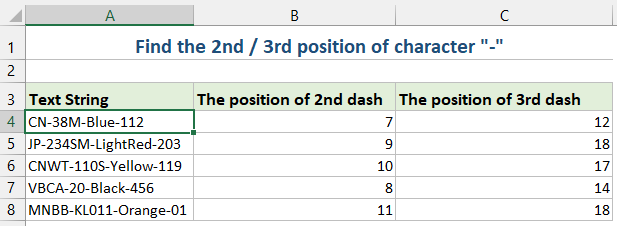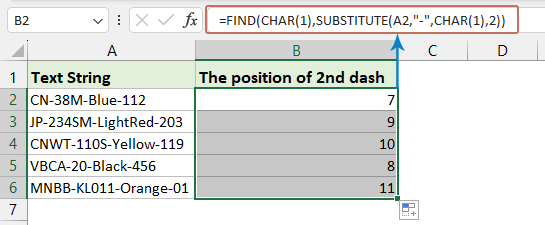Den n-ten Vorkommen eines Zeichens in Excel finden – 3 schnelle Methoden
Das Auffinden des n-ten Vorkommens eines bestimmten Zeichens innerhalb einer Textzeichenfolge in Excel kann besonders nützlich bei der Datenanalyse sein, wo Sie möglicherweise Zeichenfolgen analysieren oder Informationen auf der Grundlage bestimmter Trennzeichen oder Muster extrahieren müssen. Zum Beispiel, lassen Sie uns das 2. oder 3. Vorkommen des Zeichens "-" in einer Textzeichenfolge finden. Ich werde einfache Techniken demonstrieren, um diese Aufgabe effizient zu erledigen.

Den n-ten Vorkommen eines Zeichens in einer Textzeichenfolge mit Formel finden
Sie können eine Formel erstellen, um das n-te Vorkommen eines Zeichens zu finden. Bitte gehen Sie wie folgt vor:
1. Geben Sie die folgende Formel in eine Zelle ein oder kopieren Sie sie dorthin, wo Sie das Ergebnis erhalten möchten:
=FIND(CHAR(1),SUBSTITUTE(A2,"-",CHAR(1),2))- "A2": Die Zelle, die die Zeichenfolge enthält.
- "-": Das Zeichen, nach dem Sie suchen.
- "2": Das 2. Vorkommen, das Sie finden möchten, Sie können es je nach Bedarf in 3, 4… ändern.
2. Ziehen Sie dann die Formel nach unten, um die Formel in andere Zellen zu füllen, und die 2. Position des Zeichens – werden sofort angezeigt, siehe Screenshot:
- "SUBSTITUTE" ersetzt das n-te Vorkommen des Zeichens durch ein nicht druckbares Zeichen (CHAR(1)).
- "FIND" sucht nach diesem nicht druckbaren Zeichen und gibt die Position des n-ten Vorkommens zurück.
Den n-ten Vorkommen eines Zeichens in einer Textzeichenfolge mit Kutools für Excel finden
Wenn Sie kein Fan von Formeln oder VBA sind, könnten Sie eine praktische Alternative in Betracht ziehen – "Kutools für Excel". Innerhalb seiner Formelgruppen finden Sie ein nützliches Hilfsmittel – "Finde, wo das Zeichen N-tes Mal in einer Zeichenfolge erscheint", das schnell die n-te Position eines beliebigen Zeichens in einer Zelle identifiziert und zurückgibt.
Nach der Installation von Kutools für Excel klicken Sie auf "Kutools" > "Formelhelfer" > "Formelhelfer", um das Dialogfeld "Formelhelfer" zu öffnen. Klicken Sie auf eine Zelle, wo Sie das Ergebnis platzieren möchten. Gehen Sie dann wie folgt vor:
- Wählen Sie "Suchen" aus der Dropdown-Liste im Abschnitt "Formeltyp";
- Wählen Sie "Finde, wo das Zeichen N-tes Mal in einer Zeichenfolge erscheint" im Abschnitt "Wählen Sie eine Formel";
- Wählen Sie die Zelle aus, die die Zeichenfolge enthält, die Sie verwenden, und geben Sie dann das angegebene Zeichen und das n-te Vorkommen in die Textfelder im Abschnitt "Argumenteingabe" ein;
- Klicken Sie abschließend auf die Schaltfläche "OK", um das Ergebnis zu erhalten.

Kutools für Excel - Verleihen Sie Excel mit über 300 essenziellen Tools einen echten Schub. Nutzen Sie dauerhaft kostenlose KI-Funktionen! Holen Sie es sich jetzt
Den n-ten Vorkommen eines Zeichens in einer Textzeichenfolge mit benutzerdefinierter Funktion finden
In diesem Abschnitt werden wir untersuchen, wie man eine UDF erstellt und verwendet, um das n-te Vorkommen eines Zeichens in Excel zu finden, wobei eine Schritt-für-Schritt-Anleitung bereitgestellt wird, um Ihnen bei der Optimierung Ihrer Datenverarbeitung zu helfen.
- Halten Sie die Tasten "ALT" + "F11" gedrückt, und es öffnet sich das Fenster "Microsoft Visual Basic for Applications".
- Klicken Sie auf "Einfügen" > "Modul" und fügen Sie das folgende Makro im Modulfenster ein.
Function FindN(sFindWhat As String, _ sInputString As String, N As Integer) As Integer 'Updateby Extendoffice Dim J As Integer Application.Volatile FindN = 0 For J = 1 To N FindN = InStr(FindN + 1, sInputString, sFindWhat) If FindN = 0 Then Exit For Next End Function - Schließen Sie dann das VBA-Fenster. Gehen Sie zurück zum Arbeitsblatt, geben Sie die folgende Formel in eine Zelle ein und ziehen Sie den Ausfüllkursor nach unten, um die Formel in andere Zellen zu füllen, siehe Screenshot:
=FindN("-",A2,3)
- Zählen Sie die Anzahl der Vorkommen eines Wortes in einer Spalte
- Wenn Sie über eine Spalte mit Daten verfügen, die einige doppelte Werte enthält, wie im folgenden Screenshot gezeigt, und nun möchten Sie die Anzahl der Vorkommen eines bestimmten Wortes in dieser Spalte zählen. Mit diesem Tutorial stelle ich einige Tricks vor, um dies schnell in Excel zu lösen.
- Ersetzen Sie die ersten n Zeichen oder das n-te Vorkommen eines Zeichens durch ein anderes
- In Excel ersetzen wir normalerweise einen String mit der Funktion Suchen und Ersetzen, aber wenn Sie sich in einem der folgenden Fälle befinden, kann die Funktion Suchen und Ersetzen Ihnen nicht helfen.
- Extrahieren Sie ein n-tes Zeichen aus einer Zeichenfolge
- Normalerweise möchten Sie möglicherweise eine Zeichenfolge nach einem bestimmten Zeichen extrahieren, aber in diesem Fall möchte ich das n-te Zeichen aus einer Zeichenfolge extrahieren, wie im folgenden Screenshot gezeigt.
- Die ersten/letzten n Zeichen aus einer Zeichenfolge extrahieren
- Angenommen, es gibt eine Liste mit langen Zeichenfolgen in jeder Zelle, und Sie möchten nur die ersten n Zeichen aus jeder Zeichenfolge extrahieren, wie die ersten 3 Zeichen jeder Zeichenfolge, und jetzt können Sie die folgenden Methoden verwenden, um dies in Excel zu lösen.
Verwandte Artikel:
Die besten Produktivitätstools für das Büro
Stärken Sie Ihre Excel-Fähigkeiten mit Kutools für Excel und genießen Sie Effizienz wie nie zuvor. Kutools für Excel bietet mehr als300 erweiterte Funktionen, um die Produktivität zu steigern und Zeit zu sparen. Klicken Sie hier, um die Funktion zu erhalten, die Sie am meisten benötigen...
Office Tab bringt die Tab-Oberfläche in Office und macht Ihre Arbeit wesentlich einfacher
- Aktivieren Sie die Tabulator-Bearbeitung und das Lesen in Word, Excel, PowerPoint, Publisher, Access, Visio und Project.
- Öffnen und erstellen Sie mehrere Dokumente in neuen Tabs innerhalb desselben Fensters, statt in neuen Einzelfenstern.
- Steigert Ihre Produktivität um50 % und reduziert hunderte Mausklicks täglich!
Alle Kutools-Add-Ins. Ein Installationspaket
Das Kutools for Office-Paket bündelt Add-Ins für Excel, Word, Outlook & PowerPoint sowie Office Tab Pro und ist ideal für Teams, die mit mehreren Office-Anwendungen arbeiten.
- All-in-One-Paket — Add-Ins für Excel, Word, Outlook & PowerPoint + Office Tab Pro
- Ein Installationspaket, eine Lizenz — in wenigen Minuten einsatzbereit (MSI-kompatibel)
- Besser gemeinsam — optimierte Produktivität in allen Office-Anwendungen
- 30 Tage kostenlos testen — keine Registrierung, keine Kreditkarte erforderlich
- Bestes Preis-Leistungs-Verhältnis — günstiger als Einzelkauf der Add-Ins

